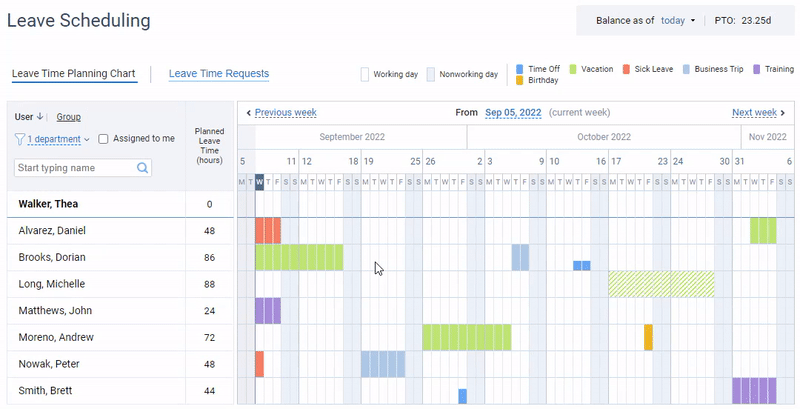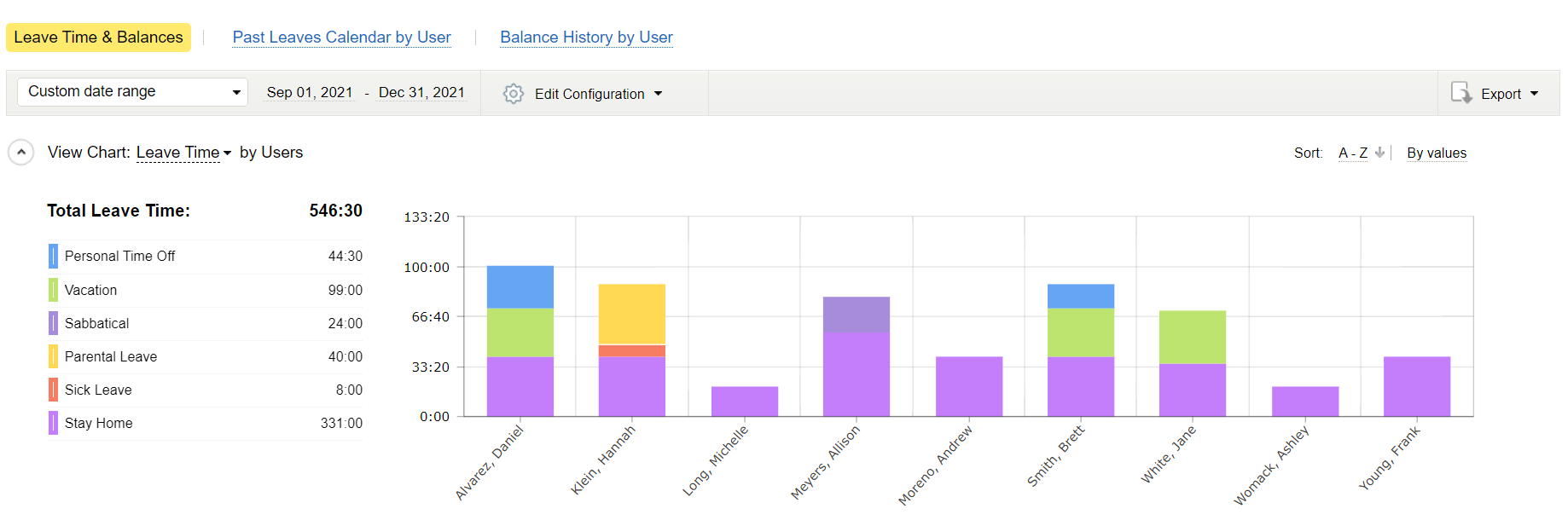So, you’ve just welcomed a new employee to the team and they’re bursting with energy and fresh ideas. But wait! When exactly can they start enjoying their paid time off (PTO)?
Navigating the realm of PTO waiting periods can feel like walking a tightrope – an act of balancing your company’s policy with employee satisfaction.
Fear not, though! With a bit of know-how, setting up a fair and effective PTO waiting period is easier than it seems.
In this guide, we’ll delve into this art of delay, giving you the lowdown on how to implement a PTO waiting period that keeps both your business and your employees happy.
Ready to master the balance?
Let’s dive in.
What Is a PTO Waiting Period?
A PTO waiting period is the time a new employee needs to be employed with a company before they can start using their PTO benefits. Typically, this period can range from 30 days to six months, depending on your organizational policies.
Companies set this timeframe to ensure that employees are committed and settled into their roles before they take time off. And from an employee’s perspective, it’s like waiting to unwrap a gift – a little patience, and then you get to enjoy your well-earned break!
The Whys and Wherefores of the PTO Waiting Period
In essence, a PTO waiting period is meant to create a smoother, more committed, and budget-friendly working environment for everyone involved. Here are the primary reasons behind this concept:
- Employee commitment and retention: Simply put, the waiting period helps ensure that new employees are serious about their roles and plan to stick around for a while. It’s like a commitment handshake. By introducing a waiting period, companies avoid the frustration of granting PTO to someone who might leave before they’ve really settled in.
- Budget management: From a financial perspective, a PTO waiting period helps companies manage their budgets more effectively. It gives them time to integrate new hires into their payroll system without immediately factoring in PTO payouts. This little buffer can make a significant difference in terms of staff-related costs, especially for smaller companies.
- Workforce planning: Managing a team’s schedule often feels like playing Tetris. Introducing a waiting period helps managers plan workload and project timelines with the confidence that new employees will be available during the critical early stages of their hiring period. It minimizes last-minute scheduling hiccups.
- Encouraging early engagement: For new employees, the initial phase in a new job is crucial for building relationships and understanding the corporate culture. The waiting period ensures that they are present and engaged during these formative weeks, rather than taking time off immediately which could hinder their integration process.
PTO Waiting Period: Implementation Examples
- 90-day waiting period: This is pretty common and straightforward. New hires must complete three months of employment before becoming eligible for PTO. It helps ensure that the company isn’t immediately impacted by absences and gives employees a period to fully understand their roles and responsibilities.
- Accrual-based system: Another way to implement a waiting period is through an accrual-based system. This means employees start earning PTO from day one, but they can only use it after, say, 30 or 60 days. It’s a nice middle ground – employees feel like they’re accumulating benefits without the company taking a hit too soon.
- Staggered waiting periods: Some companies opt for a tiered approach. For example, they might offer a few sick days right away but require a six-month wait for vacation days. This method balances immediate needs with long-term planning and keeps the benefits both attractive and sustainable.
How to Accrue PTO with a Waiting Period
Let’s suppose your employees can earn 15 days of PTO per year, but there’s a 90-day waiting period before they begin to accrue that time off. Here’s the math to figure it all out:
- Annual PTO days: 15 days
- Yearly accrual in days: There are 52 weeks in a year, which includes 52 weekends plus 5 workdays per week. Multiply those 5 workdays by 52 weeks:
- Daily accrual rate: Given you earn 15 days of PTO over 260 working days:
- Accrual after the waiting period: You begin to accrue PTO after 90 days. From day 91 onward, you’ll start earning 0577 days per workday.
- Example for the remainder of the year: If your waiting period ends and you have 195 working days left:
Pro tip:
As a smart resource scheduling solution, actiPLANS helps to manage your PTO effectively and stress-free:
- First off, it takes the guesswork out of tracking your PTO balance – no more tedious manual calculations or confusing spreadsheets. With actiPLANS, everything is automated and updated in real time, so you always know exactly how much leave you’ve earned.
- Besides, actiPLANS streamlines the approval process, making it super easy for you to request time off and for managers to approve it with just a few clicks. This means fewer delays and more transparency.

Sign up for a free trial to see how actiPLANS can simplify PTO management.
How to Implement a PTO Waiting Period Effectively
Step 1: Communicate the Policy Clearly
First things first, you need to be crystal clear about the new policy. Send out an email, update your employee handbook, and maybe even hold a meeting to explain the details. Make sure everyone understands that there will be a waiting period before they can use their PTO. Transparency is key here.
Step 2: Define the Waiting Period
Decide on the length of the waiting period. Typical durations range from 30 to 90 days depending on company norms and industry standards. Whatever duration you choose, make sure it aligns with your overall corporate culture and employee expectations.
Also, make sure to keep it reasonable! More than 90 days, and you risk harming team morale and enthusiasm.
Step 3: Update Your Payroll System
You want your payroll system to reflect the new PTO policy. This means updating your HR software or any tracking system you use to account for the waiting period. This step is crucial to avoid any confusion or miscalculations in the future.
Step 4: Monitor Compliance
After implementing the policy, keep an eye on it to ensure that both managers and employees are adhering to the new rules. Periodic reviews or check-ins can help you determine if the waiting period is being respected and functioning as intended.
Step 5: Offer Support and Flexibility
While it’s important to enforce the waiting period, be ready to offer support and show some flexibility in exceptional cases.
Life happens, and there might be instances where new hires need to take time off unexpectedly. Handling these situations with empathy can set a positive tone and reinforce your company’s commitment to employee well-being.
Here are a few examples of leave types you can exclude from the waiting period:
- Medical emergencies: Life throws curveballs, like sudden illnesses or unexpected surgeries. In such critical times, the best option is to let your team members bypass the waiting period so they can focus on recovery without the added stress of waiting for PTO eligibility.
- Bereavement leave: Coping with the loss of a loved one is tough enough without the pressure of a PTO waiting period. Thus, offering bereavement leave from day one and allowing employees space to grieve and handle family affairs is more than just a nice gesture – it’s a sign of genuine care.
- Jury duty: Getting called for jury duty can be both an honor and an inconvenience. Luckily, many workplaces understand this civic responsibility and allow employees to take time off immediately, without waiting for PTO to kick in.
Step 6: Track Leave Time Consistently
Tracking PTO using actiPLANS is a smart move for any organization. First off, it helps streamline the entire process, reducing the need for endless back-and-forth emails and complicated spreadsheets.
actiPLANS offers a centralized platform where all PTO requests and approvals take place, making everything more transparent and manageable.
Here’s how you can make the most of it:
- Set up your team: Start by adding all team members to the platform. There, you will easily keep everyone on the same page and provide access to PTO self-service tools.
- Customize policies: Tailor PTO accrual rules to fit your company’s specific needs. You can clarify the number of days off employees will earn per year, set PTO blackout days, accrual caps, etc.
- Request and approve easily: Employees can easily submit PTO requests through the app, and managers can approve or deny them just as quickly. This instant feedback loop speeds up the process and helps in planning workloads better.
- Monitor balances: Employees and managers can keep track of PTO balances in real time, avoiding any confusion about how many days off are available. This transparency helps in planning future vacations without any last-minute surprises.
- Generate reports: The powerful reporting feature allows you to visualize and analyze PTO trends and usage. It is invaluable for spotting patterns and making data-driven decisions.

By using actiPLANS, you not only save time and reduce administrative burdens but also create a more organized and happier workforce. Try it out to see how it works!
Step 7: Celebrate Milestones
Make the end of the waiting period a notable occasion. Recognize the completion with a small celebration or a personal acknowledgment from a manager. It reinforces a positive workplace culture and instills a sense of accomplishment in your employees.
Additional Resources for Better PTO Management
1. Complete Guide on Vacation Accrual
Confused about how to handle PTO accruals? Our guide is here to demystify the process and help you establish a fair and efficient system. It offers expert knowledge on keeping your workforce happy and your records straight.
Ready to master vacation accrual? Dive in here.
2. Unusual Leave Policies
Looking to stand out as an employer while keeping your team motivated and satisfied? Then, check out our article on unusual leave policies!
It will walk you through some creative and effective PTO benefits that not only promote work-life balance but also boost employee morale. Whether it’s an unlimited vacation or days off for volunteering, these innovative ideas could be the exact thing your company needs.
Intrigued? Click this link for more.
3. Paid Holidays by Law
Are you curious about how paid holidays differ on both sides of the pond? You’re in for a fascinating read.
In our articles, we dive into the specifics of managing different leave types in the US and Europe. From statutory requirements to cultural variations, we break down everything you need to know. These insights will be as eye-opening as they are informative.
Don’t miss out! Explore the US legal nuances here and the European ones here.
4. Comprehensive Absence Management Guide
Navigating employee absences can be a real headache, right? But don’t worry – our absence management guide is here to ease the burden.
Packed with practical tips and useful information, it will help you handle everything from unexpected sick days to planned vacations seamlessly.
Discover how to turn staff absences into opportunities here.
Conclusion
Implementing a PTO waiting period can be a strategic move that balances company needs with employee expectations. By thoughtfully establishing a clear policy, open communication, and fair enforcement, you set the stage for a more productive and satisfied workforce.
Remember, it’s not just about setting rules – it’s about creating a culture where employees feel valued and understand the rationale behind company policies. So, take our tips and examples, adapt them to your unique context, and make your PTO waiting period a win-win for everyone involved.



